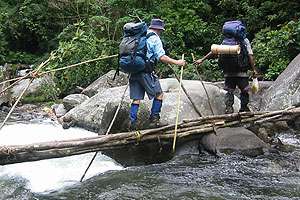Kokoda Track
Understand
What is now known as the Kokoda Track was a collection of trails and trading routes used by villagers to cross the Owen Stanley Range and travel from the south to north coast of Papua New Guinea for hundreds of years, and in the 19th century by Europeans keen to reach the goldfields on the northern half of the island.
Even today, with up to a thousand trekkers camped along the track each night in peak season, there is not a single route from what is now known as Owers Corner in the south to the Kokoda Valley in the north, but alternative tracks that go through different valleys and different villages for about 98 kilometres.
The track became famous during the Second World War when troops of the 39th Australian Infantry Battalion and Japanese Imperial Forces fought a long and arduous battle along its route to prevent the Japanese forces from reaching Port Moresby in the south, and thus a potential starting point for an invasion of mainland Australia.
Since then, and particularly in the past two decades, walking the Kokoda Track has become a rite of passage for Australians of all ages, on a par with visiting Gallipoli on Anzac Day. However, trek parties of more than 100 trekkers and guides mean the track is no longer the isolated place it once was.
Certainly it is difficult for Australians and Japanese to not shed a few tears when they reach the war memorial site at Isurava.

Prepare
The most important thing for a prospective Kokoda trekker to think about is footwear. Get good shoes and really good socks are a must. Without those you will get terrible blisters on your feet and might get junglerot, which will put you in crutches for a long while and might cost you your feet. Every morning you should rub your feet with petroleum jelly and every night with talcum powder to keep them in shape for the walk.
The second thing is the importance of a decent water purifying system; iodine pills work great but they taste awful so think about complementing that with water purification tablets to take away the taste. Sometimes it might be far between the streams to refill your bottles so be sure to carry a few (or one of those snazzy camel packs.) A flashlight or even better, a headlamp is almost a must as it gets very dark in the jungle at night. It's also important to bring warmer clothes to wear at camp since the weather up in the mountains is quite cold at night and sometimes even during the day.
Before walking the Kokoda it is also important to carefully assess how fit you are. There are incidents of people dying of heart attacks (most recently the summer of 2006) from over-exertion. There are several speeds at which one can walk the Kokoda, taking from a leisurely 10 days to a gruesome 16 hours, 34 minutes and 5 seconds, the world record held by local porter Brendan Buka. Basically the most important thing is that you have fun doing it. Going too fast isn't fun, but taking it too slow can be boring also if you have to wait for the others all the time.
Get in
If time or stamina is a problem you can join the Kokoda Track in the middle. Airlines PNG flies to Efogi, Kagi and Manari and from Port Moresby, as well as to Kokoda. The southern starting point can be reached by road from Port Moresby. Kokoda can also be reached by road from Popondetta, which receives regular flights by Air Niugini .
